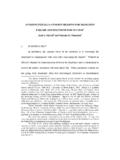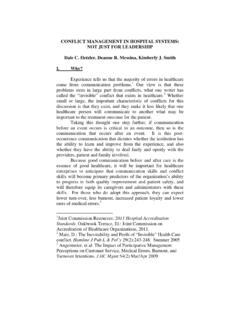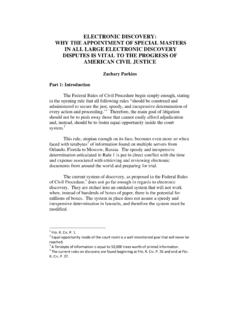Transcription of CONCRETIZING THE MEDIATOR’S JE NE SAIS QUOI …
1 CONCRETIZING THE mediator 'S. JE NE SAIS quoi : emotional intelligence AND. THE effective mediator . Courtney Chicvak All learning has an emotional base. Plato I. Introduction The job market for mediators is unique: there are few formal limitations imposed upon individuals who seek to become mediators, yet the number of positions available for mediators is limited. Therefore, an imbalance arises between supply and demand in the job Thus, the laissez-faire market regulates who may act as a full-time mediator on the basis of that mediator 's reputation, which is generally developed by word-of-mouth client and attorney experiences during mediations. Consequently, an individual may receive more or fewer cases based upon parties'. desire for a particular individual to mediate a In the legal profession, attorneys who seek to become mediators generally pursue some level of coursework in the area of Alternative Dispute Resolution prior to entering into this unique field, and they possess an overall understanding of the techniques and tools a mediator may use to effectively and efficiently assist parties in resolving a Particularly in the case of attorney- mediators, they have natural strengths and inclinations towards reasoning and logic and are well equipped to assist parties in 1.
2 See generally Marty Nemko, mediator : Executive Summary, US NEWS AND. WORLD REPORT, executive-summary (last visited Apr. 21, 2013) (estimating that there are only 10,000 mediators in the United States earning approximately $50,000 a year from mediations, and a large number earning less.). 2. Urska Velikonja, Making Peace and Making Money: Economic Analysis of the Market for Mediators, 72 ALB. L. REV. 257 (2009) (discussing the economics of pursuing a career as a full-time mediator ). 3. BRINGING PEACE INTO THE ROOM: HOW THE PERSONAL QUALITIES OF THE. mediator IMPACT THE PROCESS OF CONFLICT RESOLUTION (Daniel Bowling &. David Hoffman eds., 2003). designing workable solutions to resolve the issues at Yet, despite the level of academic achievement or knowledge of mediation techniques and tools, some attorney-mediators are more successful in settling cases, thereby building a reputation and continuing to operate as full-time I propose the missing link, or je ne sais quoi , that allows mediators to develop such admirable reputations, and, subsequently, viable careers in the area of mediation, is a mediator 's awareness of and possession of emotional intelligence during the course of the mediation process.
3 A subset of the theory of multiple intelligences, emotional intelligence is defined as the ability to perceive accurately, appraise, and express emotion; the ability to access and/or generate feelings when they facilitate thought; the ability to understand emotion and emotional knowledge; and the ability to regulate emotions to promote emotional and intellectual growth. 6. In this paper, I will define emotional intelligence and establish the value of this type of intelligence by providing examples that demonstrate the added value it provides to the mediation process. I will also show how emotional intelligence is a critical component of the role of a mediator . I will explain the acquisition of emotional intelligence and how, although emotional intelligence cannot be learned per se, it can be improved upon as any other type of intelligence . 4. Id. 5. Velikonja, supra note 2, at 257. 6. PETER SALOVEY & JOHN D. MAYER, emotional intelligence : KEY. READINGS ON THE MAYER AND SALOVEY MODEL 35 (Peter Salovey et al.)
4 Eds., 2004). II. Theory of Multiple Intelligences Philosophers such as Darwin and Plato have noted the important role emotions play in However, the theory of multiple intelligences, including emotional intelligence , was not proposed as a formal area of scientific study until the 1980's. 8. Since the initial studies of the theory of multiple intelligences spearheaded by Howard Gardner, it has been further developed by a wide array of To understand the theory of emotional intelligence , one must first depart from the traditional definition of intelligence . The traditional model is based on two fundamental assumptions: first, that human cognition is unitary, and second, that each individual possesses an intelligence that is single and quantifiable. 10 Contrarily, the theory of multiple intelligences suggests that each person has several different potential competencies and that these competencies may not be easily measured by numerical and verbal tests. Therefore, the definition of intelligence within the theory of multiple intelligences model is an individual's ability to make or offer a service valued by others and to solve problems that are encountered on a day-to-day 7.
5 See, Kendra Cherry, emotional intelligence What It Is and Why It Matters, , (last visited Apr. 10, 2013). 8. Howard Gardner published his thesis proposing the theory of multiple intelligences in 1983. See HOWARD GARDNER, FRAMES OF MIND: THE THEORY. OF MULTIPLE INTELLIGENCES (3rd ed. 2011). 9. Many theories exist, but this is beyond the scope of this paper. Overall, it can be said that academics agree that there are different areas of intelligence . 10. Salovey, supra note 6, at 4-6. 11. Howard Garner, the pioneer of the theory of multiple intelligences, identified nine areas of multiple intelligences. (1) Linguistic intelligence is the capacity to use language to express what's on ones mind and how to understand other people through the use of language, (2) Logical/Mathematical intelligence is the capacity to understand the underlying principles of some kind of causal system, (3) Musical Rhythmic intelligence is the capacity to think in music, to be able to hear patterns, recognize them, and perhaps manipulate them, (4).
6 Bodily/Kinesthetic intelligence is the capacity to use one's whole body or parts of one's body to solve a problem, make something, or put on some kind of production, (5) Spatial intelligence is the ability to represent the spatial world internally in one's mind, (6) Naturalist intelligence is the ability to discriminate among living things and sensitivity to other features of the natural world, (7). Intrapersonal intelligence is having an understanding of oneself, knowing who one is, what one can do, what one desires to do, and how one reacts to things, Despite the variations that have developed since the basic theory of multiple intelligences was initially announced, academics who have performed further research on each of the particular branches are in agreement that social intelligence exists. Because of the varying levels of conceptualization of the theory of a social intelligence12, for the purposes of this paper I will rely upon the theory promulgated by Salovey and Mayer, the most respected among social 1.
7 The Rise of Emotion: In What Context Does emotional intelligence Arise? In the Salovey and Mayer model of emotional intelligence , the phenomenon of experiencing emotions is as follows: first, an external or internal event will occur. In response to the event, an individual will be either positively or negatively affected in some way. The effect could be either tangible or intangible. The emotion, or a mixture of emotions, will arise in the wake of the event as a manifestation of the individual's perception of the event's effects upon him. 14 The event-impact emotion model is intuitive because it is something experienced by all on a day-to-day basis. (8) Interpersonal intelligence is the ability to understand other people, (9). Existential intelligence is the ability and proclivity to pose and ponder questions about life, death, and ultimate realities. According to the theory of multiple intelligences, one form of intelligence is not preferable over another, and instead, each is equally viable and valuable.
8 An individual may possess more than one of these intelligences in different degrees. See generally, Theory of Multiple Intelligences, , (last visited Apr. 10, 2013). 12. Beyond the scope of this paper, some contend that emotional intelligence may overlap with personality traits or individual creativity. See generally, KEVIN R. MURPHY, A CRITIQUE OF emotional intelligence (Lawrence Erlbaum Assoc., Inc. 2006); Jeffery M. Conte, A Review and Criticism of emotional intelligence Measures, 26 J. ORGANIZ. BEHAV. 433, 433-440 (2005). 13. The existence of a social intelligence has become axiomatic in the field of organizational behavior. See generally, Salovey, supra note 6; Peter Reilly, Mindfulness, Emotions, and Mental Models: Theory that Leads to More effective Dispute Resolution, 10 NEV. 433, 436-438 (2010). 14. Salovey, supra note 6, at 61-80. An example of the event-impact-emotion sequence would be as follows: Person A leaves work and walks to his car to go home for the night. Once arriving at his car, Person A reaches in his pocket and realizes that he left his car keys on his office desk.
9 Person A is annoyed to walk back inside, mainly because it is very cold outside, and he would like to leave the office to avoid traffic. Here, the external event would be Person A leaving the car keys on his desk. In response to the event, leaving the keys on the desk, Person A was negatively affected because he had planned on leaving work at a certain time and also did not want to walk back to the building in the cold. The effects are both tangible and intangible: tangible because he remained outside and faces a greater likelihood he will drive in traffic on the way home, and intangible because of the time Person A spends walking back to the building. Based upon the above facts, Person A was annoyed. Changing the facts around, if Person A had been seeking a promotion at work and did not mind going back into the building to get his keys, as a way to speak with his boss about his latest project, Person A instead might have been content with returning to the building. 2. The Response to Emotion: Applying emotional intelligence Once an event has occurred, the effect realized by the individual and the subsequent emotion has arisen, the next point to ascertain is the individual's response to the emotion.
10 At this juncture, emotional intelligence intervenes. The general area of emotional intelligence can further be divided into four sub- branches that facilitate in the understanding of what occurs once emotions have arisen. 15 Similar to Maslow's hierarchy, the branches are arranged in ascending order, from the most basic processes to the most integrated processes. The four branches are (1) emotional perception and expression, (2) emotional facilitation of thought, (3) emotional understanding, and (4). emotional management. 16. The first branch, emotional perception and expression, . deals with the most fundamental and foundational aspects of emotional intelligence : one's ability to identify, to perceive, and to 15. Id. 16. Id. express emotions. 17 To recognize emotions, individuals rely on external cues or tip-offs such as facial expressions, body language, and vocal intonation. 18 To provide a further breakdown of the branch of emotional perception and expression, one is capable of identifying emotions in oneself and others, as well as the ability to accurately express one's own emotions and to be able to distinguish authentic and phony emotional expressions of An example would be the following: Person C smiles, and Person D identifies the emotion experienced by Person C as happiness.











